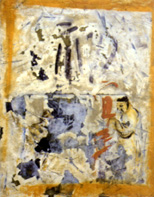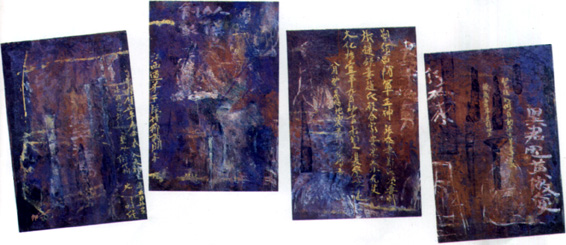 "Meditation" - combined technique (146cm x 114cm) - Mio Pang Fei.
"Meditation" - combined technique (146cm x 114cm) - Mio Pang Fei.
The following texts are some of the main critical references from the catalogues of two exhibitions which took place in Macau in February: the solo exhibition by Mio Pang Fei and the joint exhibition by Kwok Woon and Guilherme Ung Vai Meng.
"And let us leave the colours and their combinations as great subject for those who best understand them given that many who have eyes cannot judge them since there are no words to convey the miracles which colours and their great power can achieve."
Francisco d'Ollanda
"On Ancient Painting".
Chapter 37, XVIth Century.
I have been following Mio Pang Fei's pictorial quest closely over the last five years and have been amazed at his immense geographic feeling for colours, and his mineralogical sensitivity towards the materials which he employs when building up his pictures. The splashes of colour, textures, ruts, craters, relievos all emerge as if they were natural phenomena - the stream of water sculpts its mother-cliff; the rain rots a fallen leaf weaving an almost filigree effect; the sun silvers the ores clustered as in a jeweller's shop; the dew makes the green leaves sensual adorning them with pearly nipples; the erosion creates fleeting forms; the humid heat washes the earthy pigmentation in water-colours; the moon drapes the sea with silver in readiness for the dawn of the night above all nights of a thousand stars; in other words, this part of the world seems to be dedicated to Nature. A Nature which is similar to ours but which neither belongs to us nor is experienced by us. Nor is it inhabited by men and women. Mio Pang Fei grows his colours in the right places (natural nurseries?) in a seemingly natural, accidental way. In fact, after extensive premeditation and before the decision, he controls everything. This is his geographical logic in an abundant nature whose laws are dictated by him. The laws of lawlessness. Nor are there even visible inhabitants. They were certainly chimeras of a pre-parmenidean existence wrapped in hyperuranic liquids, before the waters of the brutal birth in the uterine volcano of the human condition broke. In this phase they are transformed into pure abstractions of material exaltation.
It is an almost voracious obsession with the substance of objects, colours and their coalescence. In a seemingly precipitate stroke, the brush explores the whole surface, wreaking order from havoc and immediately subsiding ecstatically in the mirror of the delta's water which his hand has just poured forth. He occasionally completes his work with a few Chinese pictogrammes which are abstracted to such a degree as to be illegible. Sometimes he transcribes poems onto his paintings only to bury them under a lava-coloured ink on the following day. Mio Pang Fei foments a chromatic and textural archeology which he excavates from Han dust and often seems to prefer to the dynastic pictographs and refined stylizations of the Tang Dynasty. Mio Pang Fei is a profoundly coherent and complete painter. He does not follow fashions but rather an objective which has been defined for over thirty years: that is to develop a meaningful and dramatic, abstractionist and often gestural self-expression where the traces of Chinese culture, which are his cherished heritage, are embodied in a style of painting which is typically Western. Not only because of this but also because of this I have a profound admiration and respect for Mio Pang Fei.
Mio Pang Fei
• 1936: Born in Shanghai
• 1958: Completes higher studies in Painting at the Fu Jian Province Normal Institute (Faculty of Fine Arts).
• 1960: In charge of the general planning for Fu Jian Province Agricultural Exhibition.
• 1961: Founds an "atelier' in Shanghai for teaching Western design and painting.
• 1964: Starts work as a graphic artist and joins the Shanghai Association of Technical Artists.
• 1965: First creative phase (most of his early works were destroyed).
• 1975: Teacher in the Shanghai School of Applied Arts.
In particular, he gives classes in interior decoration, painting and design.
• 1977: Publishes the book Studies on Designs for Packaging Toys in Chinese (sixty thousand characters).
• 1979: Presents a dissertation on the theory of Western art - "From the Italian Renaissance to Impressionism, Cubism and Abstractionism".
• 1980: Finished his thesis on "Cubism and Picasso".
Enters his period of pure abstractionism."
Participates in the publication of countless texts on Plastic Arts.
• 1982: Participates in an exhibition in Great Britain.
Art Exhibition in Shanghai.
Exhibition of Paintings by Teachers and Students of theDepartment of Plastic Arts in Shanghai Polytechnical School.
• 1984: Collective exhibition by the "Association of Chinese Painters and Calligraphers of Macau/Yu Yun".
• 1985: Collective exhibition of the Fine Arts Association of Macau.
Collective exhibition by the "Association of Chinese Painters and Calligraphers of Macau/Yu Yun".
2nd Exhibition of Artists of Macau, M. L. C., in the Gallery of the Leal Senado where he wins a "Special Mention for Composition".
Exhibition in the Gallery of the Luís de Camões Museum with his wife Um Chi Iam.
• 1986: Studies painting and silk-screening in the School of Fine Arts in Oporto with a scholarship from the Cultural Institute of Macau.
Exhibition in the E. G. Gallery in Oporto. Wins the "Macau Tourism Prize" in the 7th Autumn Exhibition in the Art Gallery of the Estoril Casino.
•1987: Founding Member of the Contemporary Painting section of the Friends of Culture Circle.
Participates in the 1st Exhibition organized by the N. P. C. - C. A. C., : "9 Artists".
Joins the editorial section of the Cultural Institute of Macau as a graphic artist.
Contributor and illustrator for R. C., Review of Culture.

"In Past Times " - combined technique (540cm x 200cm) - Mio Pang Fei.
start p. 49
end p.